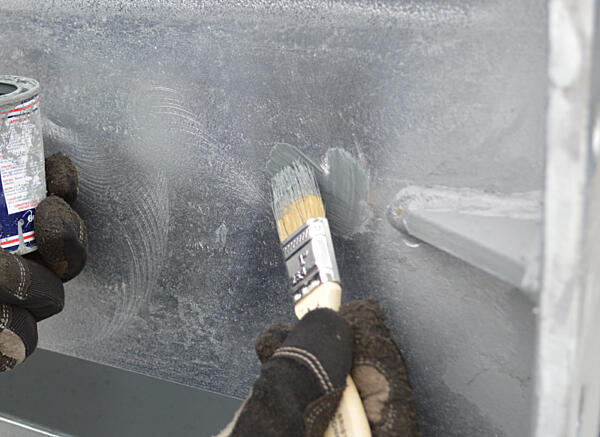Zinc-Rich Paint

Zinc painting, commonly referred to by the misnomer "cold galvanizing," is the application by brush or spray of zinc dust mixed with organic or inorganic binders. Prior to application, the steel must be cleaned by sand blasting to near white metal (SSPC-SP 10), commercial blast cleaning (SSPC-SP 6), or white metal (SSPC-SP 5). The zinc dust must be mixed with a polymeric-containing vehicle and constantly agitated during application to produce a homogenous mixture and proper adhesion.
Zinc-rich paints contain 65-95% metallic zinc in dry film, with 92-95% being common. The paints can be brushed or sprayed onto the steel. When spray applying, feed lines should be kept as short as possible to prevent settling of zinc dust and uneven film coats. Zinc painting can be applied in either the shop or the field.
Zinc-rich paint can be applied to steel of any size and shape, though the application is difficult on more complex fabrications. Zinc-rich paints are also widely used as primers to high-performance two and three-coat systems and for repair of batch hot-dip galvanized coatings. In mild environments, inorganic zinc paint may be used independently for corrosion protection, but should be top coated in more severe environments to extend service life. Limitations to zinc-rich paint include life-cycle cost, difficulty in applying, lack of coating uniformity (particularly at corners and edges), and the requirement for a clean steel surface.
Coating Characteristics
Like all paint coatings, zinc-rich paint is a surface coating, mechanically bonded to the steel at a few hundred pounds per square inch (psi). Zinc-rich paints are either organic, consisting of epoxies, chlorinated hydrocarbons, and other polymers; or inorganic based on organic alkyl silicates. The organic or inorganic paints are applied to a dry film thickness of 2.5 to 3.5 mils (64-90 µm).
One commonality of all zinc coatings is the cathodic protection afforded. However, zinc-rich paint coatings are different than the others as there is a binding material used to adhere zinc particles. For cathodic protection to be possible, the zinc dust must be at a concentration high enough to provide for conductivity between the zinc particles and the steel. This is another reason constant agitation and homogenous mixture is important during application. There is some question as to whether cathodic protection is possible at all if the zinc particles are encapsulated in the binder and the binder is non-conductive.
Inorganic and organic zinc-rich paints vary somewhat in their performance. Inorganic zinc-rich paints, which adhere to the steel with mild chemical reactivity, have good solvent resistance and can withstand temperatures up to about 700 F (375 C). Inorganic zinc-rich paints do not chalk, peel, or blister readily, are easy to weld, and provide simpler cleanup than organics. The density of inorganic zinc-rich paints is about half the density of zinc per mil of batch hot-dip galvanized coatings.
The properties of organic zinc-rich paints depend on the solvent system. Multiple coats may be applied within 24 hours without cracking. Organic zinc-rich paints do not have the same temperature resistance as inorganic zincs, as they are limited to 200-300 F. They are also subject to ultraviolet (sunlight) degradation and are not as effective as inorganics in corrosion resistance.
